Business Law Report: Analysis of UK Business Law and Legal Solutions
VerifiedAdded on 2020/10/22
|11
|3703
|302
Report
AI Summary
This report provides an in-depth analysis of UK business law, beginning with an overview of the English legal system's structure, including civil and criminal law, and the sources of law that organizations must comply with, such as common law, legislation, and human rights law. It examines the government's role in making law, outlining the procedural steps involved. The report then delves into employers' legal obligations, including occupational health and safety, worker's compensation, harassment, and equal opportunities, and assesses the impact of employment and contract law on specific business scenarios. Furthermore, it explores legal solutions for business problems, such as unfair dismissal and insurance claims, justifying these solutions based on relevant legal principles. Finally, it touches upon the concept and benefits of alternative distribution processes and proposes alternative legal solutions for the case studies presented.
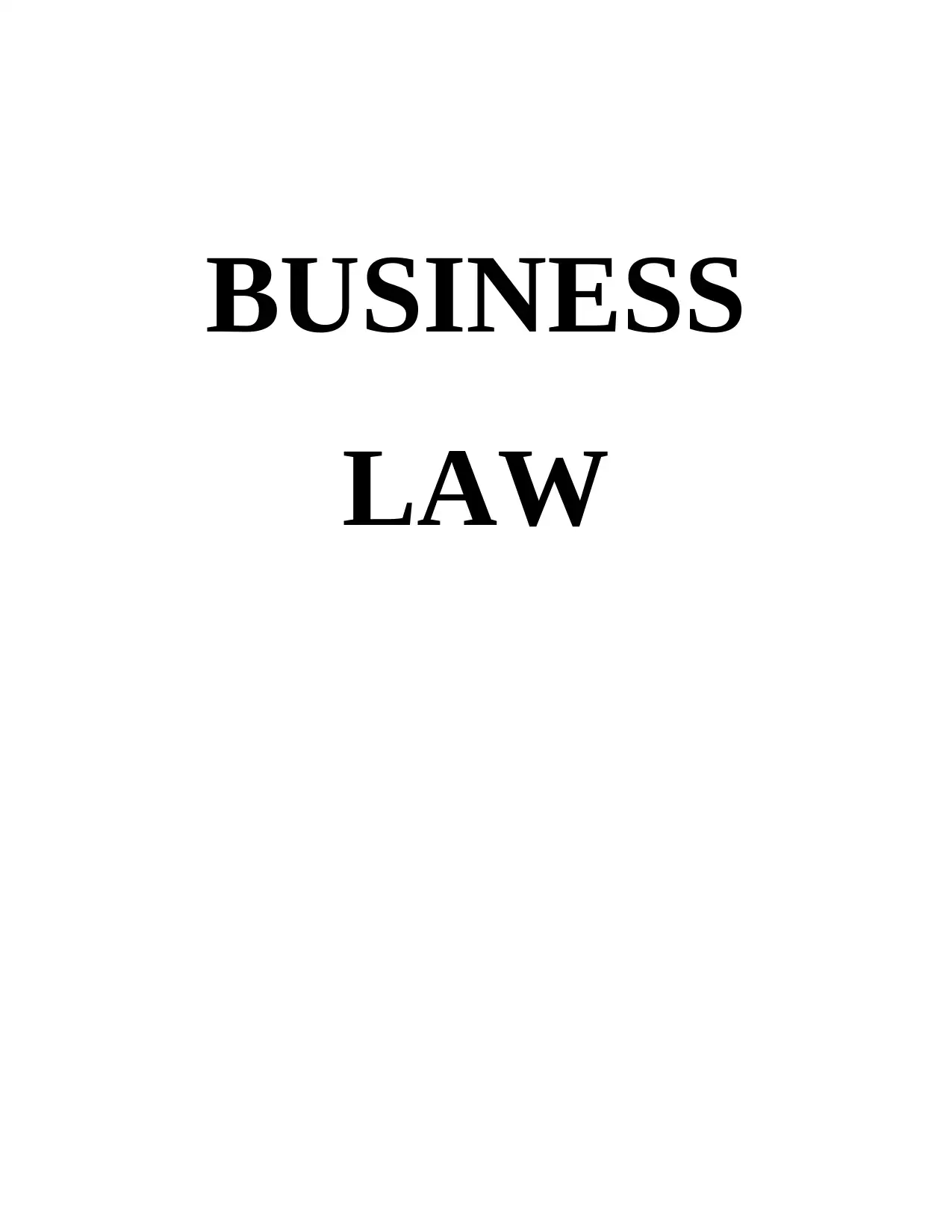
BUSINESS
LAW
LAW
Paraphrase This Document
Need a fresh take? Get an instant paraphrase of this document with our AI Paraphraser
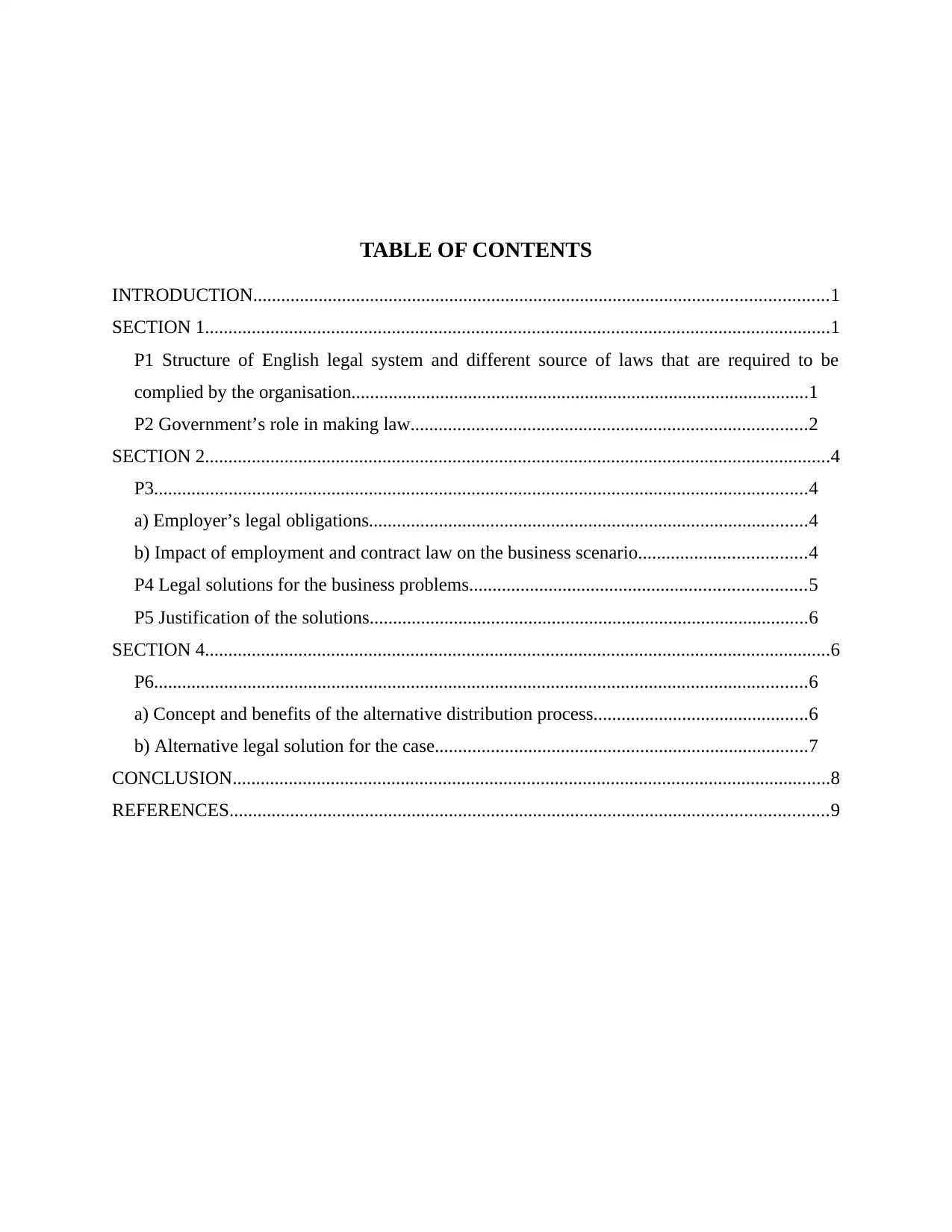
TABLE OF CONTENTS
INTRODUCTION...........................................................................................................................1
SECTION 1......................................................................................................................................1
P1 Structure of English legal system and different source of laws that are required to be
complied by the organisation..................................................................................................1
P2 Government’s role in making law.....................................................................................2
SECTION 2......................................................................................................................................4
P3............................................................................................................................................4
a) Employer’s legal obligations..............................................................................................4
b) Impact of employment and contract law on the business scenario....................................4
P4 Legal solutions for the business problems........................................................................5
P5 Justification of the solutions..............................................................................................6
SECTION 4......................................................................................................................................6
P6............................................................................................................................................6
a) Concept and benefits of the alternative distribution process..............................................6
b) Alternative legal solution for the case................................................................................7
CONCLUSION................................................................................................................................8
REFERENCES................................................................................................................................9
INTRODUCTION...........................................................................................................................1
SECTION 1......................................................................................................................................1
P1 Structure of English legal system and different source of laws that are required to be
complied by the organisation..................................................................................................1
P2 Government’s role in making law.....................................................................................2
SECTION 2......................................................................................................................................4
P3............................................................................................................................................4
a) Employer’s legal obligations..............................................................................................4
b) Impact of employment and contract law on the business scenario....................................4
P4 Legal solutions for the business problems........................................................................5
P5 Justification of the solutions..............................................................................................6
SECTION 4......................................................................................................................................6
P6............................................................................................................................................6
a) Concept and benefits of the alternative distribution process..............................................6
b) Alternative legal solution for the case................................................................................7
CONCLUSION................................................................................................................................8
REFERENCES................................................................................................................................9
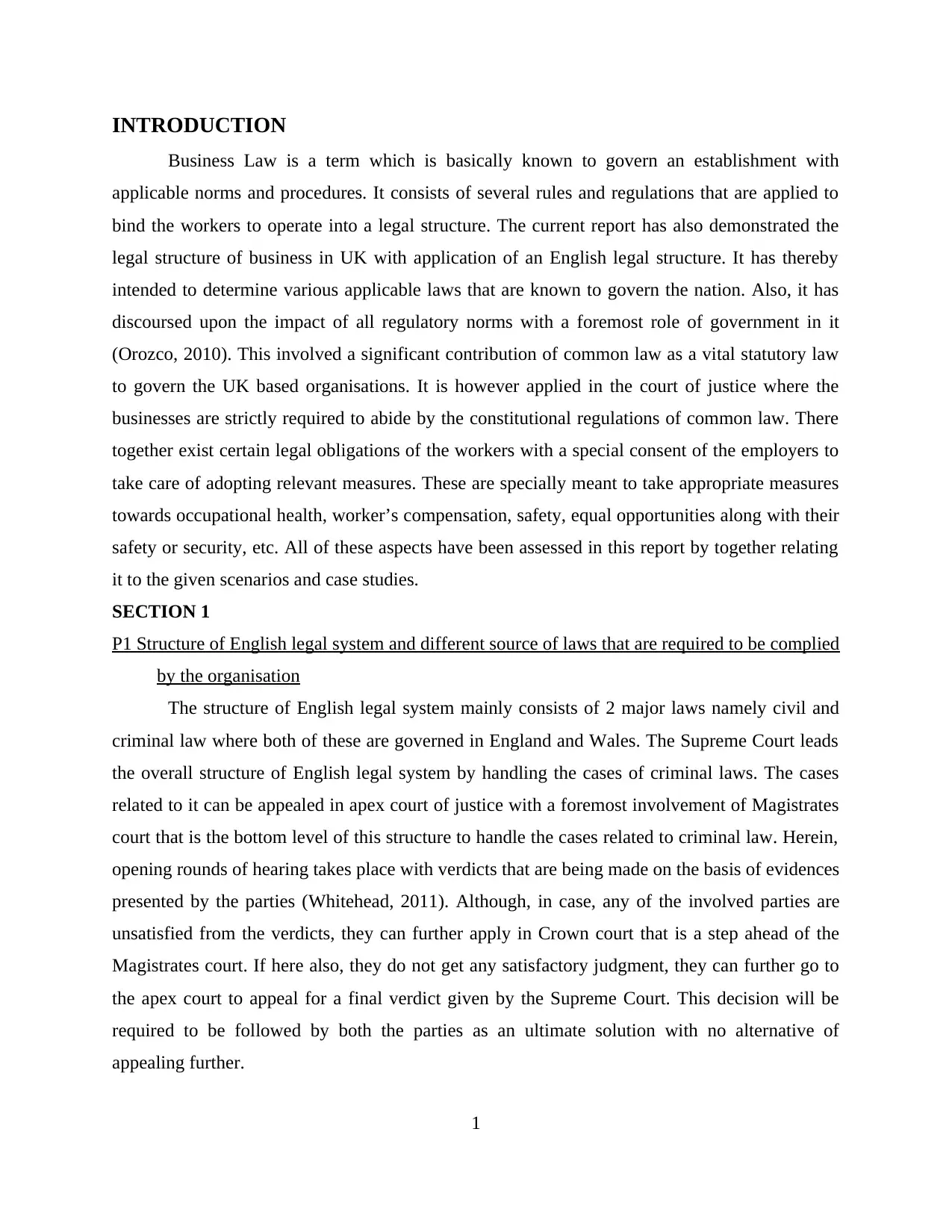
INTRODUCTION
Business Law is a term which is basically known to govern an establishment with
applicable norms and procedures. It consists of several rules and regulations that are applied to
bind the workers to operate into a legal structure. The current report has also demonstrated the
legal structure of business in UK with application of an English legal structure. It has thereby
intended to determine various applicable laws that are known to govern the nation. Also, it has
discoursed upon the impact of all regulatory norms with a foremost role of government in it
(Orozco, 2010). This involved a significant contribution of common law as a vital statutory law
to govern the UK based organisations. It is however applied in the court of justice where the
businesses are strictly required to abide by the constitutional regulations of common law. There
together exist certain legal obligations of the workers with a special consent of the employers to
take care of adopting relevant measures. These are specially meant to take appropriate measures
towards occupational health, worker’s compensation, safety, equal opportunities along with their
safety or security, etc. All of these aspects have been assessed in this report by together relating
it to the given scenarios and case studies.
SECTION 1
P1 Structure of English legal system and different source of laws that are required to be complied
by the organisation
The structure of English legal system mainly consists of 2 major laws namely civil and
criminal law where both of these are governed in England and Wales. The Supreme Court leads
the overall structure of English legal system by handling the cases of criminal laws. The cases
related to it can be appealed in apex court of justice with a foremost involvement of Magistrates
court that is the bottom level of this structure to handle the cases related to criminal law. Herein,
opening rounds of hearing takes place with verdicts that are being made on the basis of evidences
presented by the parties (Whitehead, 2011). Although, in case, any of the involved parties are
unsatisfied from the verdicts, they can further apply in Crown court that is a step ahead of the
Magistrates court. If here also, they do not get any satisfactory judgment, they can further go to
the apex court to appeal for a final verdict given by the Supreme Court. This decision will be
required to be followed by both the parties as an ultimate solution with no alternative of
appealing further.
1
Business Law is a term which is basically known to govern an establishment with
applicable norms and procedures. It consists of several rules and regulations that are applied to
bind the workers to operate into a legal structure. The current report has also demonstrated the
legal structure of business in UK with application of an English legal structure. It has thereby
intended to determine various applicable laws that are known to govern the nation. Also, it has
discoursed upon the impact of all regulatory norms with a foremost role of government in it
(Orozco, 2010). This involved a significant contribution of common law as a vital statutory law
to govern the UK based organisations. It is however applied in the court of justice where the
businesses are strictly required to abide by the constitutional regulations of common law. There
together exist certain legal obligations of the workers with a special consent of the employers to
take care of adopting relevant measures. These are specially meant to take appropriate measures
towards occupational health, worker’s compensation, safety, equal opportunities along with their
safety or security, etc. All of these aspects have been assessed in this report by together relating
it to the given scenarios and case studies.
SECTION 1
P1 Structure of English legal system and different source of laws that are required to be complied
by the organisation
The structure of English legal system mainly consists of 2 major laws namely civil and
criminal law where both of these are governed in England and Wales. The Supreme Court leads
the overall structure of English legal system by handling the cases of criminal laws. The cases
related to it can be appealed in apex court of justice with a foremost involvement of Magistrates
court that is the bottom level of this structure to handle the cases related to criminal law. Herein,
opening rounds of hearing takes place with verdicts that are being made on the basis of evidences
presented by the parties (Whitehead, 2011). Although, in case, any of the involved parties are
unsatisfied from the verdicts, they can further apply in Crown court that is a step ahead of the
Magistrates court. If here also, they do not get any satisfactory judgment, they can further go to
the apex court to appeal for a final verdict given by the Supreme Court. This decision will be
required to be followed by both the parties as an ultimate solution with no alternative of
appealing further.
1
⊘ This is a preview!⊘
Do you want full access?
Subscribe today to unlock all pages.

Trusted by 1+ million students worldwide
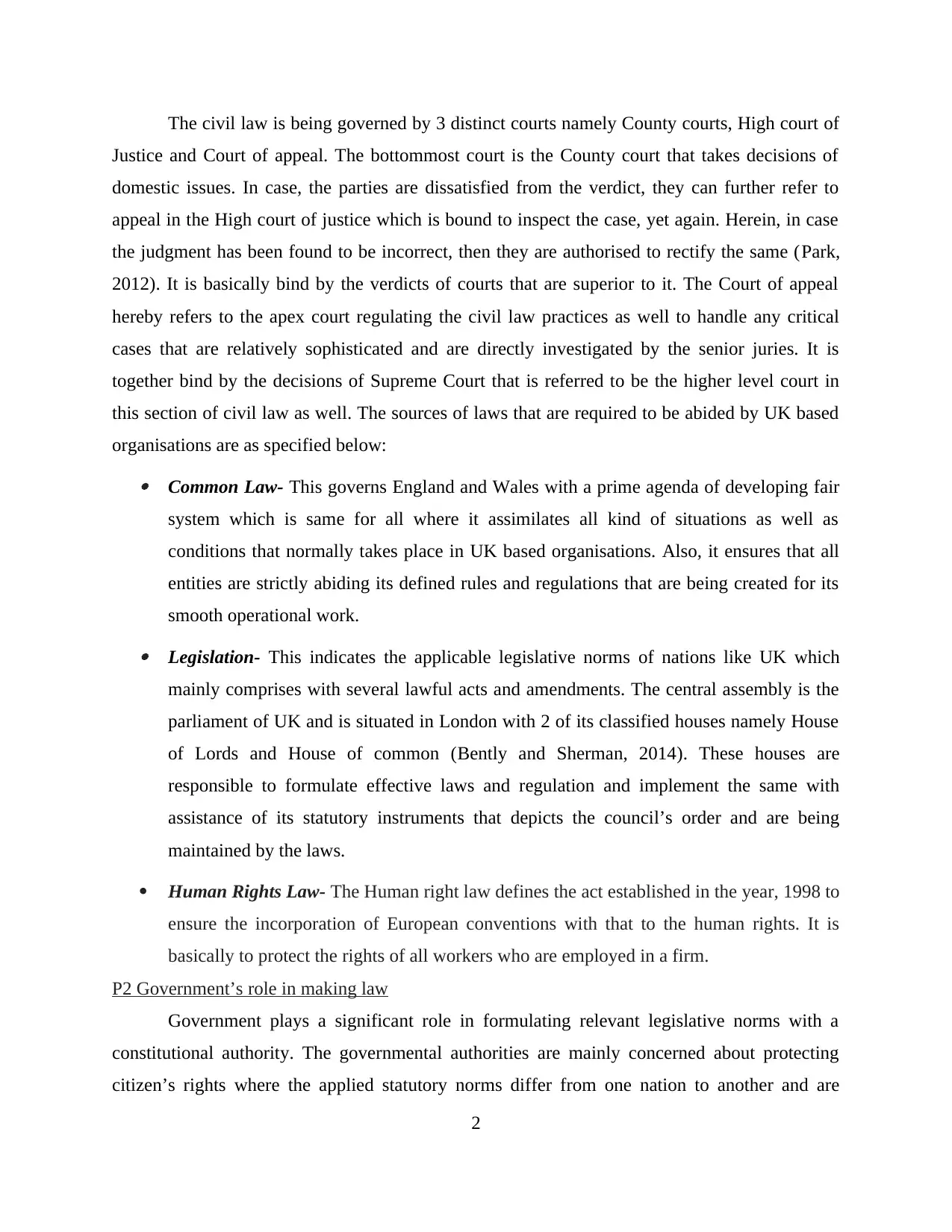
The civil law is being governed by 3 distinct courts namely County courts, High court of
Justice and Court of appeal. The bottommost court is the County court that takes decisions of
domestic issues. In case, the parties are dissatisfied from the verdict, they can further refer to
appeal in the High court of justice which is bound to inspect the case, yet again. Herein, in case
the judgment has been found to be incorrect, then they are authorised to rectify the same (Park,
2012). It is basically bind by the verdicts of courts that are superior to it. The Court of appeal
hereby refers to the apex court regulating the civil law practices as well to handle any critical
cases that are relatively sophisticated and are directly investigated by the senior juries. It is
together bind by the decisions of Supreme Court that is referred to be the higher level court in
this section of civil law as well. The sources of laws that are required to be abided by UK based
organisations are as specified below: Common Law- This governs England and Wales with a prime agenda of developing fair
system which is same for all where it assimilates all kind of situations as well as
conditions that normally takes place in UK based organisations. Also, it ensures that all
entities are strictly abiding its defined rules and regulations that are being created for its
smooth operational work. Legislation- This indicates the applicable legislative norms of nations like UK which
mainly comprises with several lawful acts and amendments. The central assembly is the
parliament of UK and is situated in London with 2 of its classified houses namely House
of Lords and House of common (Bently and Sherman, 2014). These houses are
responsible to formulate effective laws and regulation and implement the same with
assistance of its statutory instruments that depicts the council’s order and are being
maintained by the laws.
Human Rights Law- The Human right law defines the act established in the year, 1998 to
ensure the incorporation of European conventions with that to the human rights. It is
basically to protect the rights of all workers who are employed in a firm.
P2 Government’s role in making law
Government plays a significant role in formulating relevant legislative norms with a
constitutional authority. The governmental authorities are mainly concerned about protecting
citizen’s rights where the applied statutory norms differ from one nation to another and are
2
Justice and Court of appeal. The bottommost court is the County court that takes decisions of
domestic issues. In case, the parties are dissatisfied from the verdict, they can further refer to
appeal in the High court of justice which is bound to inspect the case, yet again. Herein, in case
the judgment has been found to be incorrect, then they are authorised to rectify the same (Park,
2012). It is basically bind by the verdicts of courts that are superior to it. The Court of appeal
hereby refers to the apex court regulating the civil law practices as well to handle any critical
cases that are relatively sophisticated and are directly investigated by the senior juries. It is
together bind by the decisions of Supreme Court that is referred to be the higher level court in
this section of civil law as well. The sources of laws that are required to be abided by UK based
organisations are as specified below: Common Law- This governs England and Wales with a prime agenda of developing fair
system which is same for all where it assimilates all kind of situations as well as
conditions that normally takes place in UK based organisations. Also, it ensures that all
entities are strictly abiding its defined rules and regulations that are being created for its
smooth operational work. Legislation- This indicates the applicable legislative norms of nations like UK which
mainly comprises with several lawful acts and amendments. The central assembly is the
parliament of UK and is situated in London with 2 of its classified houses namely House
of Lords and House of common (Bently and Sherman, 2014). These houses are
responsible to formulate effective laws and regulation and implement the same with
assistance of its statutory instruments that depicts the council’s order and are being
maintained by the laws.
Human Rights Law- The Human right law defines the act established in the year, 1998 to
ensure the incorporation of European conventions with that to the human rights. It is
basically to protect the rights of all workers who are employed in a firm.
P2 Government’s role in making law
Government plays a significant role in formulating relevant legislative norms with a
constitutional authority. The governmental authorities are mainly concerned about protecting
citizen’s rights where the applied statutory norms differ from one nation to another and are
2
Paraphrase This Document
Need a fresh take? Get an instant paraphrase of this document with our AI Paraphraser
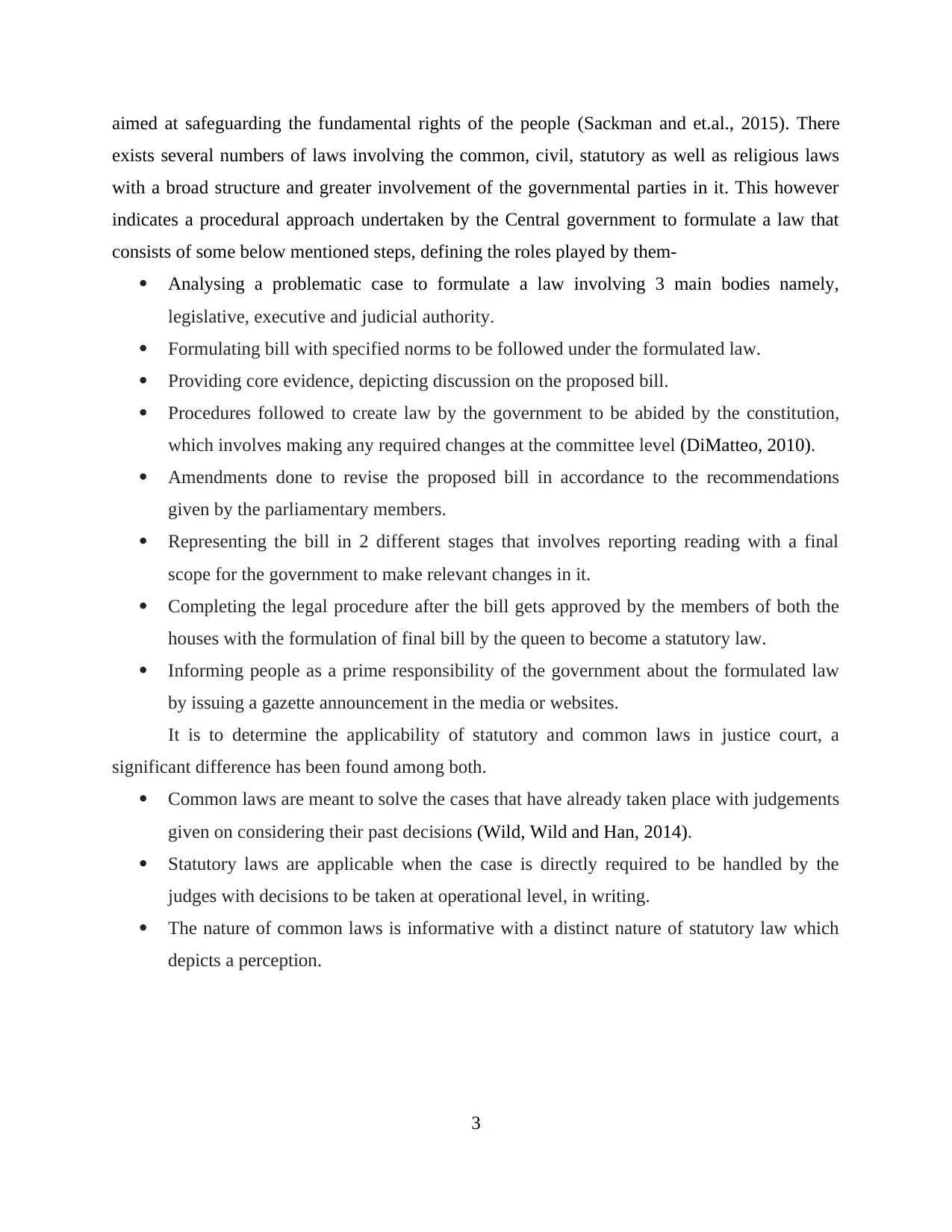
aimed at safeguarding the fundamental rights of the people (Sackman and et.al., 2015). There
exists several numbers of laws involving the common, civil, statutory as well as religious laws
with a broad structure and greater involvement of the governmental parties in it. This however
indicates a procedural approach undertaken by the Central government to formulate a law that
consists of some below mentioned steps, defining the roles played by them-
Analysing a problematic case to formulate a law involving 3 main bodies namely,
legislative, executive and judicial authority.
Formulating bill with specified norms to be followed under the formulated law.
Providing core evidence, depicting discussion on the proposed bill.
Procedures followed to create law by the government to be abided by the constitution,
which involves making any required changes at the committee level (DiMatteo, 2010).
Amendments done to revise the proposed bill in accordance to the recommendations
given by the parliamentary members.
Representing the bill in 2 different stages that involves reporting reading with a final
scope for the government to make relevant changes in it.
Completing the legal procedure after the bill gets approved by the members of both the
houses with the formulation of final bill by the queen to become a statutory law.
Informing people as a prime responsibility of the government about the formulated law
by issuing a gazette announcement in the media or websites.
It is to determine the applicability of statutory and common laws in justice court, a
significant difference has been found among both.
Common laws are meant to solve the cases that have already taken place with judgements
given on considering their past decisions (Wild, Wild and Han, 2014).
Statutory laws are applicable when the case is directly required to be handled by the
judges with decisions to be taken at operational level, in writing.
The nature of common laws is informative with a distinct nature of statutory law which
depicts a perception.
3
exists several numbers of laws involving the common, civil, statutory as well as religious laws
with a broad structure and greater involvement of the governmental parties in it. This however
indicates a procedural approach undertaken by the Central government to formulate a law that
consists of some below mentioned steps, defining the roles played by them-
Analysing a problematic case to formulate a law involving 3 main bodies namely,
legislative, executive and judicial authority.
Formulating bill with specified norms to be followed under the formulated law.
Providing core evidence, depicting discussion on the proposed bill.
Procedures followed to create law by the government to be abided by the constitution,
which involves making any required changes at the committee level (DiMatteo, 2010).
Amendments done to revise the proposed bill in accordance to the recommendations
given by the parliamentary members.
Representing the bill in 2 different stages that involves reporting reading with a final
scope for the government to make relevant changes in it.
Completing the legal procedure after the bill gets approved by the members of both the
houses with the formulation of final bill by the queen to become a statutory law.
Informing people as a prime responsibility of the government about the formulated law
by issuing a gazette announcement in the media or websites.
It is to determine the applicability of statutory and common laws in justice court, a
significant difference has been found among both.
Common laws are meant to solve the cases that have already taken place with judgements
given on considering their past decisions (Wild, Wild and Han, 2014).
Statutory laws are applicable when the case is directly required to be handled by the
judges with decisions to be taken at operational level, in writing.
The nature of common laws is informative with a distinct nature of statutory law which
depicts a perception.
3
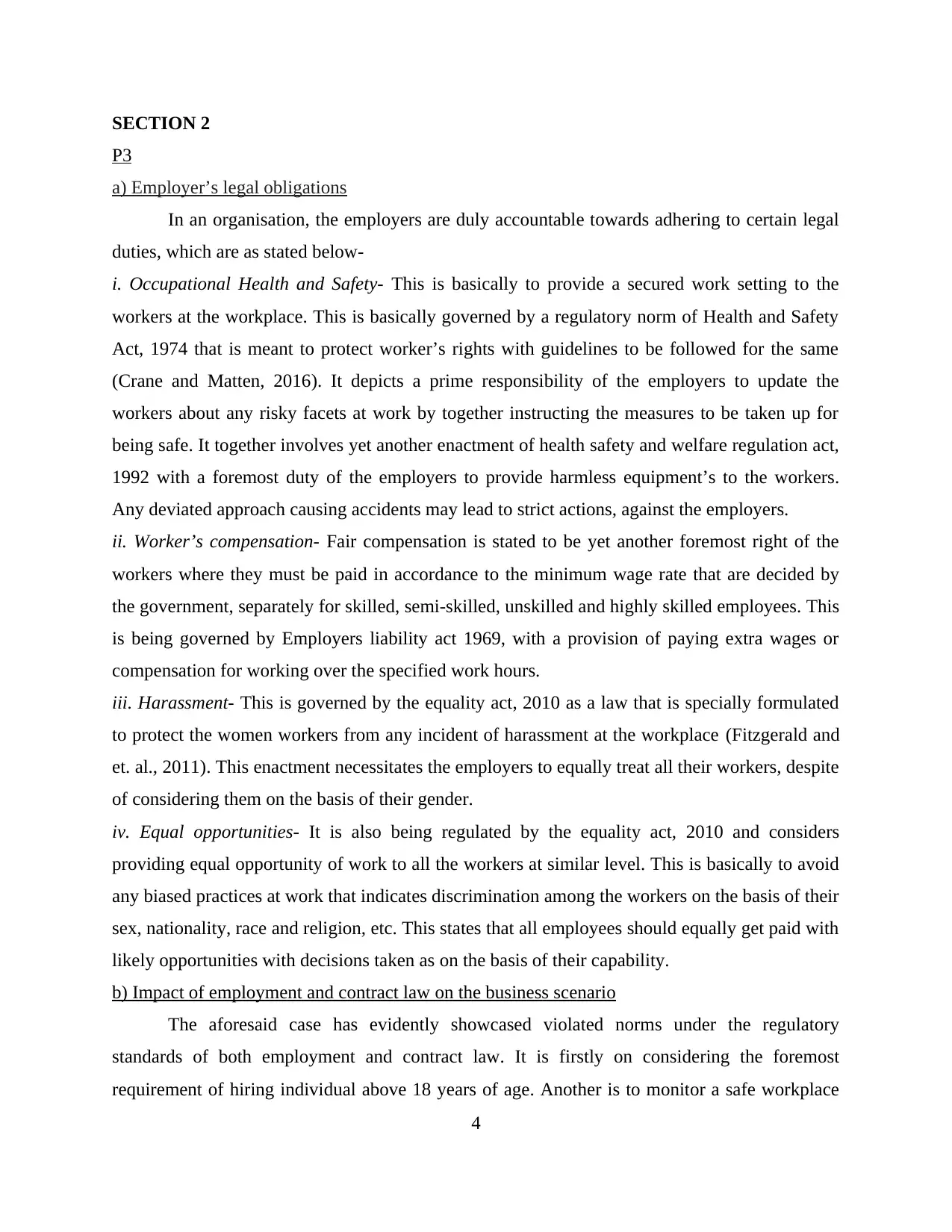
SECTION 2
P3
a) Employer’s legal obligations
In an organisation, the employers are duly accountable towards adhering to certain legal
duties, which are as stated below-
i. Occupational Health and Safety- This is basically to provide a secured work setting to the
workers at the workplace. This is basically governed by a regulatory norm of Health and Safety
Act, 1974 that is meant to protect worker’s rights with guidelines to be followed for the same
(Crane and Matten, 2016). It depicts a prime responsibility of the employers to update the
workers about any risky facets at work by together instructing the measures to be taken up for
being safe. It together involves yet another enactment of health safety and welfare regulation act,
1992 with a foremost duty of the employers to provide harmless equipment’s to the workers.
Any deviated approach causing accidents may lead to strict actions, against the employers.
ii. Worker’s compensation- Fair compensation is stated to be yet another foremost right of the
workers where they must be paid in accordance to the minimum wage rate that are decided by
the government, separately for skilled, semi-skilled, unskilled and highly skilled employees. This
is being governed by Employers liability act 1969, with a provision of paying extra wages or
compensation for working over the specified work hours.
iii. Harassment- This is governed by the equality act, 2010 as a law that is specially formulated
to protect the women workers from any incident of harassment at the workplace (Fitzgerald and
et. al., 2011). This enactment necessitates the employers to equally treat all their workers, despite
of considering them on the basis of their gender.
iv. Equal opportunities- It is also being regulated by the equality act, 2010 and considers
providing equal opportunity of work to all the workers at similar level. This is basically to avoid
any biased practices at work that indicates discrimination among the workers on the basis of their
sex, nationality, race and religion, etc. This states that all employees should equally get paid with
likely opportunities with decisions taken as on the basis of their capability.
b) Impact of employment and contract law on the business scenario
The aforesaid case has evidently showcased violated norms under the regulatory
standards of both employment and contract law. It is firstly on considering the foremost
requirement of hiring individual above 18 years of age. Another is to monitor a safe workplace
4
P3
a) Employer’s legal obligations
In an organisation, the employers are duly accountable towards adhering to certain legal
duties, which are as stated below-
i. Occupational Health and Safety- This is basically to provide a secured work setting to the
workers at the workplace. This is basically governed by a regulatory norm of Health and Safety
Act, 1974 that is meant to protect worker’s rights with guidelines to be followed for the same
(Crane and Matten, 2016). It depicts a prime responsibility of the employers to update the
workers about any risky facets at work by together instructing the measures to be taken up for
being safe. It together involves yet another enactment of health safety and welfare regulation act,
1992 with a foremost duty of the employers to provide harmless equipment’s to the workers.
Any deviated approach causing accidents may lead to strict actions, against the employers.
ii. Worker’s compensation- Fair compensation is stated to be yet another foremost right of the
workers where they must be paid in accordance to the minimum wage rate that are decided by
the government, separately for skilled, semi-skilled, unskilled and highly skilled employees. This
is being governed by Employers liability act 1969, with a provision of paying extra wages or
compensation for working over the specified work hours.
iii. Harassment- This is governed by the equality act, 2010 as a law that is specially formulated
to protect the women workers from any incident of harassment at the workplace (Fitzgerald and
et. al., 2011). This enactment necessitates the employers to equally treat all their workers, despite
of considering them on the basis of their gender.
iv. Equal opportunities- It is also being regulated by the equality act, 2010 and considers
providing equal opportunity of work to all the workers at similar level. This is basically to avoid
any biased practices at work that indicates discrimination among the workers on the basis of their
sex, nationality, race and religion, etc. This states that all employees should equally get paid with
likely opportunities with decisions taken as on the basis of their capability.
b) Impact of employment and contract law on the business scenario
The aforesaid case has evidently showcased violated norms under the regulatory
standards of both employment and contract law. It is firstly on considering the foremost
requirement of hiring individual above 18 years of age. Another is to monitor a safe workplace
4
⊘ This is a preview!⊘
Do you want full access?
Subscribe today to unlock all pages.

Trusted by 1+ million students worldwide
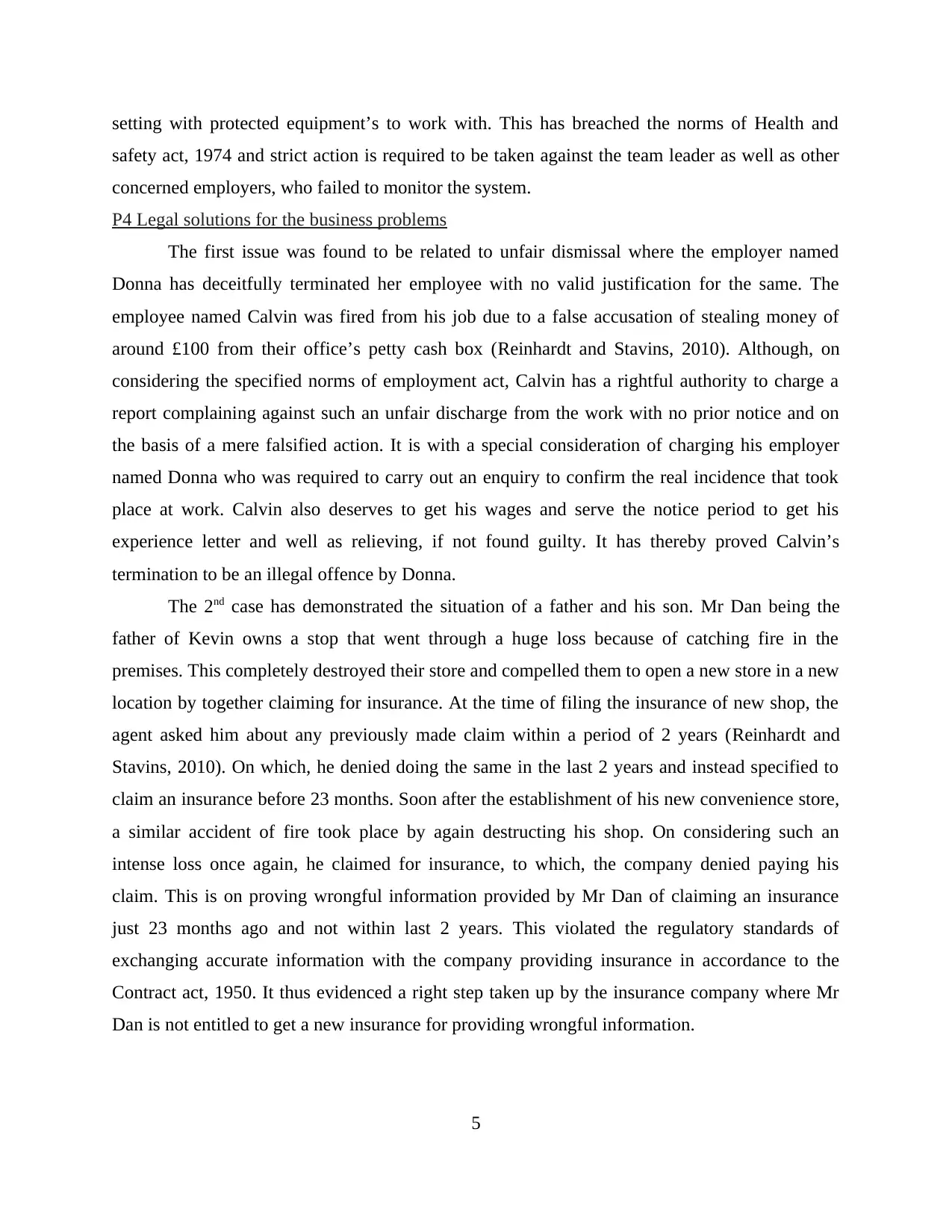
setting with protected equipment’s to work with. This has breached the norms of Health and
safety act, 1974 and strict action is required to be taken against the team leader as well as other
concerned employers, who failed to monitor the system.
P4 Legal solutions for the business problems
The first issue was found to be related to unfair dismissal where the employer named
Donna has deceitfully terminated her employee with no valid justification for the same. The
employee named Calvin was fired from his job due to a false accusation of stealing money of
around £100 from their office’s petty cash box (Reinhardt and Stavins, 2010). Although, on
considering the specified norms of employment act, Calvin has a rightful authority to charge a
report complaining against such an unfair discharge from the work with no prior notice and on
the basis of a mere falsified action. It is with a special consideration of charging his employer
named Donna who was required to carry out an enquiry to confirm the real incidence that took
place at work. Calvin also deserves to get his wages and serve the notice period to get his
experience letter and well as relieving, if not found guilty. It has thereby proved Calvin’s
termination to be an illegal offence by Donna.
The 2nd case has demonstrated the situation of a father and his son. Mr Dan being the
father of Kevin owns a stop that went through a huge loss because of catching fire in the
premises. This completely destroyed their store and compelled them to open a new store in a new
location by together claiming for insurance. At the time of filing the insurance of new shop, the
agent asked him about any previously made claim within a period of 2 years (Reinhardt and
Stavins, 2010). On which, he denied doing the same in the last 2 years and instead specified to
claim an insurance before 23 months. Soon after the establishment of his new convenience store,
a similar accident of fire took place by again destructing his shop. On considering such an
intense loss once again, he claimed for insurance, to which, the company denied paying his
claim. This is on proving wrongful information provided by Mr Dan of claiming an insurance
just 23 months ago and not within last 2 years. This violated the regulatory standards of
exchanging accurate information with the company providing insurance in accordance to the
Contract act, 1950. It thus evidenced a right step taken up by the insurance company where Mr
Dan is not entitled to get a new insurance for providing wrongful information.
5
safety act, 1974 and strict action is required to be taken against the team leader as well as other
concerned employers, who failed to monitor the system.
P4 Legal solutions for the business problems
The first issue was found to be related to unfair dismissal where the employer named
Donna has deceitfully terminated her employee with no valid justification for the same. The
employee named Calvin was fired from his job due to a false accusation of stealing money of
around £100 from their office’s petty cash box (Reinhardt and Stavins, 2010). Although, on
considering the specified norms of employment act, Calvin has a rightful authority to charge a
report complaining against such an unfair discharge from the work with no prior notice and on
the basis of a mere falsified action. It is with a special consideration of charging his employer
named Donna who was required to carry out an enquiry to confirm the real incidence that took
place at work. Calvin also deserves to get his wages and serve the notice period to get his
experience letter and well as relieving, if not found guilty. It has thereby proved Calvin’s
termination to be an illegal offence by Donna.
The 2nd case has demonstrated the situation of a father and his son. Mr Dan being the
father of Kevin owns a stop that went through a huge loss because of catching fire in the
premises. This completely destroyed their store and compelled them to open a new store in a new
location by together claiming for insurance. At the time of filing the insurance of new shop, the
agent asked him about any previously made claim within a period of 2 years (Reinhardt and
Stavins, 2010). On which, he denied doing the same in the last 2 years and instead specified to
claim an insurance before 23 months. Soon after the establishment of his new convenience store,
a similar accident of fire took place by again destructing his shop. On considering such an
intense loss once again, he claimed for insurance, to which, the company denied paying his
claim. This is on proving wrongful information provided by Mr Dan of claiming an insurance
just 23 months ago and not within last 2 years. This violated the regulatory standards of
exchanging accurate information with the company providing insurance in accordance to the
Contract act, 1950. It thus evidenced a right step taken up by the insurance company where Mr
Dan is not entitled to get a new insurance for providing wrongful information.
5
Paraphrase This Document
Need a fresh take? Get an instant paraphrase of this document with our AI Paraphraser
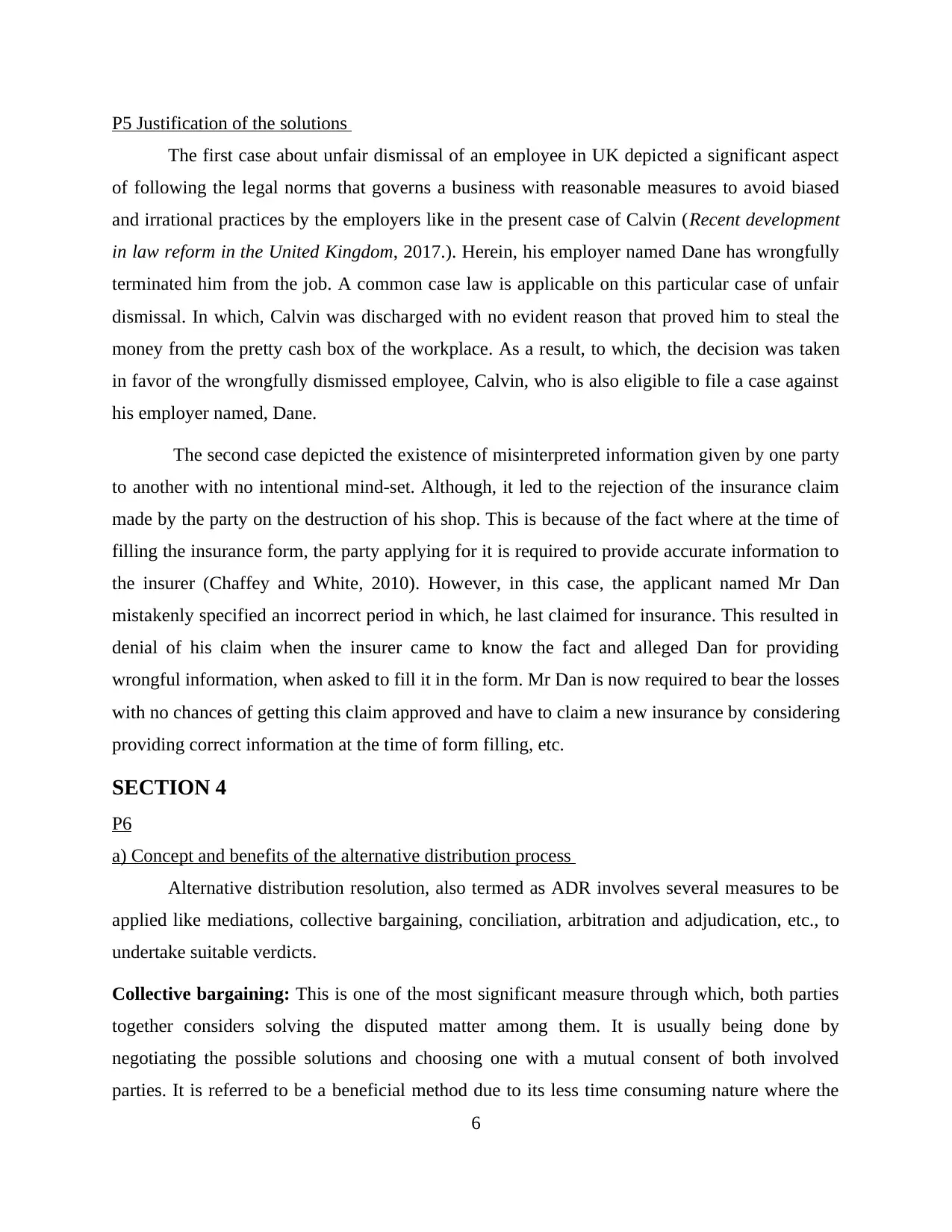
P5 Justification of the solutions
The first case about unfair dismissal of an employee in UK depicted a significant aspect
of following the legal norms that governs a business with reasonable measures to avoid biased
and irrational practices by the employers like in the present case of Calvin (Recent development
in law reform in the United Kingdom, 2017.). Herein, his employer named Dane has wrongfully
terminated him from the job. A common case law is applicable on this particular case of unfair
dismissal. In which, Calvin was discharged with no evident reason that proved him to steal the
money from the pretty cash box of the workplace. As a result, to which, the decision was taken
in favor of the wrongfully dismissed employee, Calvin, who is also eligible to file a case against
his employer named, Dane.
The second case depicted the existence of misinterpreted information given by one party
to another with no intentional mind-set. Although, it led to the rejection of the insurance claim
made by the party on the destruction of his shop. This is because of the fact where at the time of
filling the insurance form, the party applying for it is required to provide accurate information to
the insurer (Chaffey and White, 2010). However, in this case, the applicant named Mr Dan
mistakenly specified an incorrect period in which, he last claimed for insurance. This resulted in
denial of his claim when the insurer came to know the fact and alleged Dan for providing
wrongful information, when asked to fill it in the form. Mr Dan is now required to bear the losses
with no chances of getting this claim approved and have to claim a new insurance by considering
providing correct information at the time of form filling, etc.
SECTION 4
P6
a) Concept and benefits of the alternative distribution process
Alternative distribution resolution, also termed as ADR involves several measures to be
applied like mediations, collective bargaining, conciliation, arbitration and adjudication, etc., to
undertake suitable verdicts.
Collective bargaining: This is one of the most significant measure through which, both parties
together considers solving the disputed matter among them. It is usually being done by
negotiating the possible solutions and choosing one with a mutual consent of both involved
parties. It is referred to be a beneficial method due to its less time consuming nature where the
6
The first case about unfair dismissal of an employee in UK depicted a significant aspect
of following the legal norms that governs a business with reasonable measures to avoid biased
and irrational practices by the employers like in the present case of Calvin (Recent development
in law reform in the United Kingdom, 2017.). Herein, his employer named Dane has wrongfully
terminated him from the job. A common case law is applicable on this particular case of unfair
dismissal. In which, Calvin was discharged with no evident reason that proved him to steal the
money from the pretty cash box of the workplace. As a result, to which, the decision was taken
in favor of the wrongfully dismissed employee, Calvin, who is also eligible to file a case against
his employer named, Dane.
The second case depicted the existence of misinterpreted information given by one party
to another with no intentional mind-set. Although, it led to the rejection of the insurance claim
made by the party on the destruction of his shop. This is because of the fact where at the time of
filling the insurance form, the party applying for it is required to provide accurate information to
the insurer (Chaffey and White, 2010). However, in this case, the applicant named Mr Dan
mistakenly specified an incorrect period in which, he last claimed for insurance. This resulted in
denial of his claim when the insurer came to know the fact and alleged Dan for providing
wrongful information, when asked to fill it in the form. Mr Dan is now required to bear the losses
with no chances of getting this claim approved and have to claim a new insurance by considering
providing correct information at the time of form filling, etc.
SECTION 4
P6
a) Concept and benefits of the alternative distribution process
Alternative distribution resolution, also termed as ADR involves several measures to be
applied like mediations, collective bargaining, conciliation, arbitration and adjudication, etc., to
undertake suitable verdicts.
Collective bargaining: This is one of the most significant measure through which, both parties
together considers solving the disputed matter among them. It is usually being done by
negotiating the possible solutions and choosing one with a mutual consent of both involved
parties. It is referred to be a beneficial method due to its less time consuming nature where the
6

parties are not required to participate in the long trails and hearings of court. It is known to end
with suitable verdicts taken with assistance of negotiation among the involved parties by together
creating a win -win situation for both the parties. This is for instance to refer to the above case of
Calvin and Donna who can opt for this process to mutually resolve the conflicted situation. This
will also need other employers to participate and negotiate with employee representatives to plea
for the withdrawal of the case charged against Donna.
Mediation- It is stated to be yet another form of ADR that involves a mediator who is appointed
with consent of both parties. The mediator can be either a lawyer or any other person who is not
directly related to any of the parties to take fair decision (Park, 2012). This is another best
method in which, the mediator is expected to provide fair suggestions, once after hearing the
opinions of both involved parties. It is also suitable for its less time consuming nature with an
option to the parties to choose from the proposed recommendations. On adopting this approach,
Calvin and Donna can also consider resolving their disputes with no trial procedures of court.
Conciliation and adjudication: This is an ultimate option to solve the conflicted situation and is
being used when either or both of the parties are not satisfied from the above undertaken
measures. Herein, conciliation is done by appointing a head like the head of labor department, as
in the case of Calvin and Donna. Once after the proposals given by the appointed body, both the
involved parties will be required to abide the same. It is basically due to a prime involvement of
court with proper sessions and hearings in the law court.
b) Alternative legal solution for the case
This is on considering the given case where their existed a dispute among Anton and Tyrell
firms. To sort out this issue, the firm’s representatives can consider meeting to discuss the matter
in detail. This is basically on referring to the fact where both involved parties seems interested in
carrying out their business in partnership and are therefore looking to resolve the conflict, raised
between them. Negotiation is hereby referred to be the most effective tool for the same. Both
Tyrell and Antwon can refer to negotiate to come up with possible solutions to meet up their
expectations (Orozco, 2010). A collective bargaining can help them to take a valid decision with
facts to resolve the existent issues and continue the business with some newly applicable
standards. Although, both involved parties in a disputed situation needs to cooperate each other
to come to the best possible solution eradicating the existed problems. This will also include less
7
with suitable verdicts taken with assistance of negotiation among the involved parties by together
creating a win -win situation for both the parties. This is for instance to refer to the above case of
Calvin and Donna who can opt for this process to mutually resolve the conflicted situation. This
will also need other employers to participate and negotiate with employee representatives to plea
for the withdrawal of the case charged against Donna.
Mediation- It is stated to be yet another form of ADR that involves a mediator who is appointed
with consent of both parties. The mediator can be either a lawyer or any other person who is not
directly related to any of the parties to take fair decision (Park, 2012). This is another best
method in which, the mediator is expected to provide fair suggestions, once after hearing the
opinions of both involved parties. It is also suitable for its less time consuming nature with an
option to the parties to choose from the proposed recommendations. On adopting this approach,
Calvin and Donna can also consider resolving their disputes with no trial procedures of court.
Conciliation and adjudication: This is an ultimate option to solve the conflicted situation and is
being used when either or both of the parties are not satisfied from the above undertaken
measures. Herein, conciliation is done by appointing a head like the head of labor department, as
in the case of Calvin and Donna. Once after the proposals given by the appointed body, both the
involved parties will be required to abide the same. It is basically due to a prime involvement of
court with proper sessions and hearings in the law court.
b) Alternative legal solution for the case
This is on considering the given case where their existed a dispute among Anton and Tyrell
firms. To sort out this issue, the firm’s representatives can consider meeting to discuss the matter
in detail. This is basically on referring to the fact where both involved parties seems interested in
carrying out their business in partnership and are therefore looking to resolve the conflict, raised
between them. Negotiation is hereby referred to be the most effective tool for the same. Both
Tyrell and Antwon can refer to negotiate to come up with possible solutions to meet up their
expectations (Orozco, 2010). A collective bargaining can help them to take a valid decision with
facts to resolve the existent issues and continue the business with some newly applicable
standards. Although, both involved parties in a disputed situation needs to cooperate each other
to come to the best possible solution eradicating the existed problems. This will also include less
7
⊘ This is a preview!⊘
Do you want full access?
Subscribe today to unlock all pages.

Trusted by 1+ million students worldwide

formal procedure with no requirement of waiting for the court process and attend the trials and
court hearings, etc. Collective bargaining being an effective measure is expected to lead into
quick results with decisions made by the involved parties with no wastage of time, as well.
CONCLUSION
The above report has concluded a vital role of government in making effective policies
for the nation. It together assists the businesses in smoothly operating their businesses by strictly
following the governing norms. These legal standards are mostly covered with protecting the
rights of the workers employed in the company with several numbers of responsibilities of the
employers to be followed. This report has together discoursed upon such certain number of cases
to mainly discourse upon the applicable statutory norms that consisted of various legislative acts.
8
court hearings, etc. Collective bargaining being an effective measure is expected to lead into
quick results with decisions made by the involved parties with no wastage of time, as well.
CONCLUSION
The above report has concluded a vital role of government in making effective policies
for the nation. It together assists the businesses in smoothly operating their businesses by strictly
following the governing norms. These legal standards are mostly covered with protecting the
rights of the workers employed in the company with several numbers of responsibilities of the
employers to be followed. This report has together discoursed upon such certain number of cases
to mainly discourse upon the applicable statutory norms that consisted of various legislative acts.
8
Paraphrase This Document
Need a fresh take? Get an instant paraphrase of this document with our AI Paraphraser

REFERENCES
Books and Journals
Bently, L. and Sherman, B., 2014. Intellectual property law. Oxford University Press, USA.
Chaffey, D. and White, G., 2010. Business information management: improving performance
using information systems. Pearson Education.
Crane, A. and Matten, D., 2016. Business ethics: Managing corporate citizenship and
sustainability in the age of globalization. Oxford University Press.
DiMatteo, L.A., 2010. Strategic contracting: contract law as a source of competitive advantage.
American Business Law Journal. 47(4). pp.727-794.
Fitzgerald, A.M. and et.al., 2011. Internet and e-commerce law, business and policy. Thomson
Reuters (Professional) Australia Ltd.
Orozco, D., 2010. Legal knowledge as an intellectual property management resource. American
Business Law Journal. 47(4). pp.687-726.
Park, W.W., 2012. Arbitration of international business disputes: studies in law and practice.
OUP Oxford.
Reinhardt, F.L. and Stavins, R.N., 2010. Corporate social responsibility, business strategy, and
the environment. Oxford Review of Economic Policy. 26(2). pp.164-181.
Sackman, J. and et.al., 2015. Tax Issues in Condemnation Cases. Nichols on Eminent Domain.
Whitehead, C.K., 2011. The Volcker Rule and Evolving Financial Markets. Harvard Business
Law Review. 1. pp.11-19.
Wild, J., Wild, K.L. and Han, J.C., 2014. International business. Pearson Education Limited.
Online
Recent development in law reform in the United Kingdom. 2017. [Online]. Available through: <
http://svjt.se/svjt/1972/1>
9
Books and Journals
Bently, L. and Sherman, B., 2014. Intellectual property law. Oxford University Press, USA.
Chaffey, D. and White, G., 2010. Business information management: improving performance
using information systems. Pearson Education.
Crane, A. and Matten, D., 2016. Business ethics: Managing corporate citizenship and
sustainability in the age of globalization. Oxford University Press.
DiMatteo, L.A., 2010. Strategic contracting: contract law as a source of competitive advantage.
American Business Law Journal. 47(4). pp.727-794.
Fitzgerald, A.M. and et.al., 2011. Internet and e-commerce law, business and policy. Thomson
Reuters (Professional) Australia Ltd.
Orozco, D., 2010. Legal knowledge as an intellectual property management resource. American
Business Law Journal. 47(4). pp.687-726.
Park, W.W., 2012. Arbitration of international business disputes: studies in law and practice.
OUP Oxford.
Reinhardt, F.L. and Stavins, R.N., 2010. Corporate social responsibility, business strategy, and
the environment. Oxford Review of Economic Policy. 26(2). pp.164-181.
Sackman, J. and et.al., 2015. Tax Issues in Condemnation Cases. Nichols on Eminent Domain.
Whitehead, C.K., 2011. The Volcker Rule and Evolving Financial Markets. Harvard Business
Law Review. 1. pp.11-19.
Wild, J., Wild, K.L. and Han, J.C., 2014. International business. Pearson Education Limited.
Online
Recent development in law reform in the United Kingdom. 2017. [Online]. Available through: <
http://svjt.se/svjt/1972/1>
9
1 out of 11
Related Documents
Your All-in-One AI-Powered Toolkit for Academic Success.
+13062052269
info@desklib.com
Available 24*7 on WhatsApp / Email
![[object Object]](/_next/static/media/star-bottom.7253800d.svg)
Unlock your academic potential
Copyright © 2020–2025 A2Z Services. All Rights Reserved. Developed and managed by ZUCOL.





